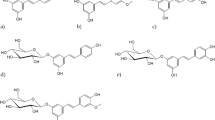Abstract
The enantiomeric composition of α-pinene in individual Norway spruce trees [Picea abies (L.) Karst.] was determined on a chiral GC column after stereoselective hydroboration-oxidation followed by a reaction with isopropyl isocyanate to form the carbamate derivative. The enantiomeric composition varied considerably between trees of different genetic origin. There was a strong correlation between the chirality of α-pinene in host spruce trees and thecis/trans ratio of verbenols found in the hindguts of the bark beetleIps typographus (L.) infesting the trees.
Similar content being viewed by others
References
Birgersson, G., Schlyter, F., Löfqvist, J., andBeroström, G. 1984. Quantitative variation of pheromone components in spruce bark beetleIps typographus from different attack phases.J. Chem. Ecol. 10:1029–1055.
Birgersson, G.,Schlyter, F.,Bergström, G., andLöfqvist, J. 1988. Individual variation in the aggregation pheromone content of the spruce bark beetle,Ips typographus.J. Chem. Ecol. Submitted.
Brändström, A., Junggren, U., andLamm, B. 1972. An improved method for the preparation of solutions of diborane.Tetrahedron Lett. 31:3173–3176.
Byers, J.A. 1981. Pheromone biosynthesis in the bark beetle,Ips paraconfusus, during feeding or exposure to vapours of host plant precursors.Insect Biochem. 11:563–569.
Comyns, A.E., andLucas, H.J. 1957. Coordination of silver ion with unsaturated compounds. IX. Solid complexes of silver salts with cyclohexene, α-pinene and β-pinene.J. Am. Chem. Soc. 79:4339–4341.
Dickens, J.C. 1981. Behavioural and electrofysiological responses to the bark beetle,Ips typographus, to potential pheromone components.Physiol. Entomol. 6:251–261.
Juvonen, S. 1966. Über die Terpenbiosynthese inPinus silvestris.Acta Bot. Fenn. 71:5–92.
Klimetzek, D., andFrancke, W. 1980. Relationship between the enantiomeric composition of α-pinene in host trees and the production of verbenols inIps species.Experentia 36:1343–1345.
König, A.W., Francke, W., andBenecke, I. 1982. Gas Chromatographic enantiomer separation of chiral alcohols.J. Chromatogr. 239:227–231.
Koscielski, T., Sybilska, D., andJurczak, J. 1983. Separation of α-pinene and β-pinene into enantiomers in gas-liquid chromatography systems via cyclodextrin inclusions complex.J. Chromatogr. 280:131–134.
Krawielitzki, S., Klimetzek, D., Bakke, A., Vité, J.P., andMori, K. 1977. Field and laboratory responce ofIps typographus to optically pure pheromonal components.Z. Angew. Entomol. 83:300–302.
Kruse, K., Francke, W., andKönig, W.A. 1979. Gas Chromatographic separation of chiral alcohols, amino alcohols and amines.J. Chromatogr. 170:423–429.
Lindström, M.,Norin, T., andRoeraade, J. 1987. Gas Chromatographic separation of monoterpene hydrocarbon enantiomers using α-cyclodextrin and formamide/water as stationary phase.J. Chromatogr. Submitted.
Mirov, N.T. 1961. Composition of gum turpentines of pines. U.S. Department of Agriculture, Technical bullentin No. 1239. ([α]D values from Beilsteins Handbuch der Organischen Chemie, Vierte Auflage, 1922, Band 5, page 146.)
Renwick, A.A., Hughes, P.R., andKrull, J.S. 1976. Selective production ofcis and trans-verbenol from (−)-α- and (+)-β-pinene by a bark beetle.Science 191:199–201.
Rudloff, E. Von. 1967. Chemosystematic studies in the genusPicea (Pinaceae). I. Introduction.Can. J. Bot., 45(6):891–901.
Schlyter, F., Birgersson, G., Byers, J.A., Löfqvist, J., andBergström, G. 1987. Field responce of the spruce bark beetle,Ips typographus, to aggregation pheromone candidates.J. Chem. Ecol. 13:701–716.
Schurig, V., Leyrer, U., andWeber, R. 1985. The use of glass and fused silica open tubular columns for the separation of structural, configurai and optical isomers by selective complexation GC: sec-alcohols and ketones.HRC & CC 8:459–464.
Silverstein, R.M., Rodin, J.O., andWood, D.L. 1966. Sex attractants in frass produced by maleIps confusus in Ponderosa pine.Science 154:509–510.
Zweifel, G., andBrown, H.C. 1964. Hydroboration of terpenes II. The hydroboration of α- pinene and β-pinene-the absolute configuration of the dialkyborane from the hydroboration of α-pinene.J. Am. Chem. Soc. 86:393–397.
Author information
Authors and Affiliations
Additional information
Coleoptera; Scolytidae.
Rights and permissions
About this article
Cite this article
Lindström, M., Norin, T., Birgersson, G. et al. Variation of enantiomeric composition of α-pinene in norway spruce,Picea abies, and its influence on production of verbenol isomers byIps typographus in the field. J Chem Ecol 15, 541–548 (1989). https://doi.org/10.1007/BF01014699
Received:
Accepted:
Issue Date:
DOI: https://doi.org/10.1007/BF01014699




